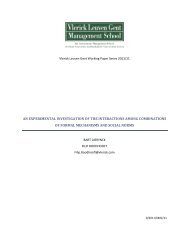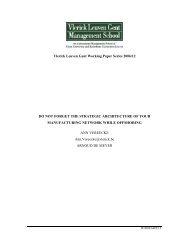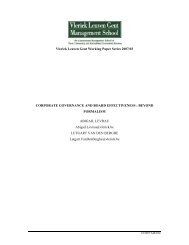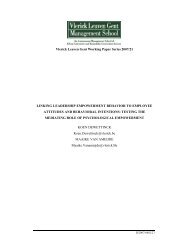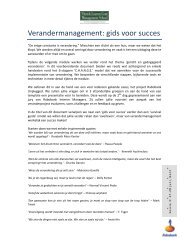innovation and internationalization by indian firms - Vlerick Public
innovation and internationalization by indian firms - Vlerick Public
innovation and internationalization by indian firms - Vlerick Public
You also want an ePaper? Increase the reach of your titles
YUMPU automatically turns print PDFs into web optimized ePapers that Google loves.
developed client relationships, a key entry barrier, <strong>and</strong> were also increasingly moving their backoffice<br />
services to India. While competition was one factor, many <strong>firms</strong> in the IT industry, used to<br />
rapid growth in their traditional service offerings, had little motivation, <strong>and</strong> hence had some inertia<br />
in shifting their focus from one based on labour-cost arbitrage to one based on knowledge.<br />
The more interesting evolution was the increasing focus on business model <strong>innovation</strong>,<br />
particularly in services. Consider the case of Bharti – a leading telecom player in India. It had<br />
developed a specific model for providing mobile phone services in India. It had focussed its activities<br />
on marketing, br<strong>and</strong> building, pricing <strong>and</strong> billing instead of the actual provision of the technology. By<br />
outsourcing many of the technology related activities such as developing <strong>and</strong> managing network<br />
equipment as well as some of the back-office IT activities such as customer data, it was able to<br />
reduce capital expenditures. This enabled the firm to focus on the customer side, <strong>and</strong> offer some of<br />
the lowest prices globally to customers, thus driving rapid market growth. In fact, together with<br />
other leading players such as Reliance Telecom, Bharti was able to bring mobile phone access to the<br />
vast interiors of India, where having a telephone had been a luxury in the past. To a large extent, this<br />
was made possible <strong>by</strong> value propositions that were oriented towards price points that combined low<br />
call rates with low-cost phones that made mobile telephony affordable to a large number of rural<br />
customers.<br />
As the Indian economy gathered pace, many Western multinationals that were still holding<br />
back in the 1990s entered the Indian market with significant commitments. To be able to compete in<br />
this qualitatively different environment (compared to Phase One), some Indian <strong>firms</strong> felt the need to<br />
focus their resources on succeeding in the domestic market. The emphasis was now increasingly on<br />
<strong>innovation</strong>, but many <strong>firms</strong> lacked capabilities, particularly in technology. Selective acquisitions <strong>by</strong><br />
companies primarily in engineering, such as <strong>by</strong> the wind-power company Suzlon <strong>and</strong> moulding<br />
company Bharat Forge, often played the role of enhancing the capability profile of the Indian <strong>firms</strong> in<br />
their ability to compete in the domestic market. Indian <strong>firms</strong>’ horizons also started exp<strong>and</strong>ing<br />
beyond their domestic markets, <strong>and</strong> domestic strategies became increasingly integrated with these<br />
<strong>firms</strong>’ global strategies.<br />
There were some limited efforts to internationalize home-grown <strong>innovation</strong>s in Phase Two.<br />
Some <strong>firms</strong> tried out international entry on a relatively small scale. For example, Mahindra &<br />
Mahindra’s launched their off-road vehicles in some African countries, while Tata Motors’ began to<br />
sell their trucks in some African <strong>and</strong> South American countries. However, these efforts were limited,<br />
<strong>and</strong> were largely driven <strong>by</strong> the forces of competition in domestic markets. Internationalization <strong>and</strong><br />
<strong>innovation</strong> in Phase Two had a qualitatively different character to Phase One; these became more<br />
asset- <strong>and</strong> capability-seeking rather than market seeking in Phase Two. This was because the focus<br />
10



